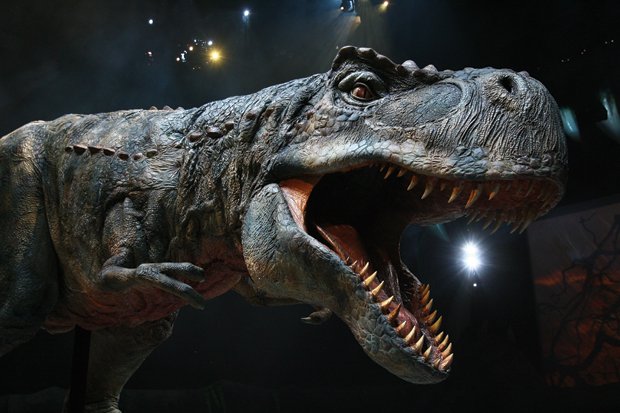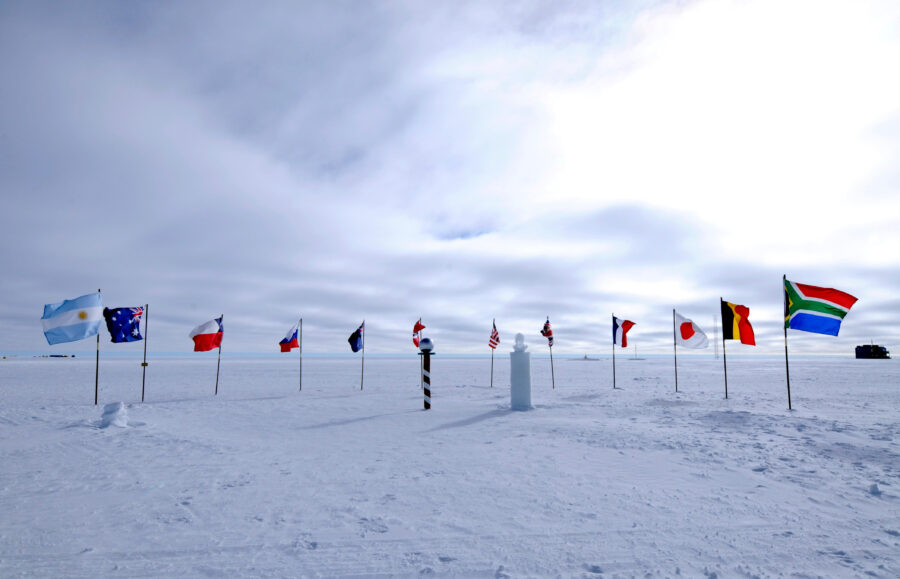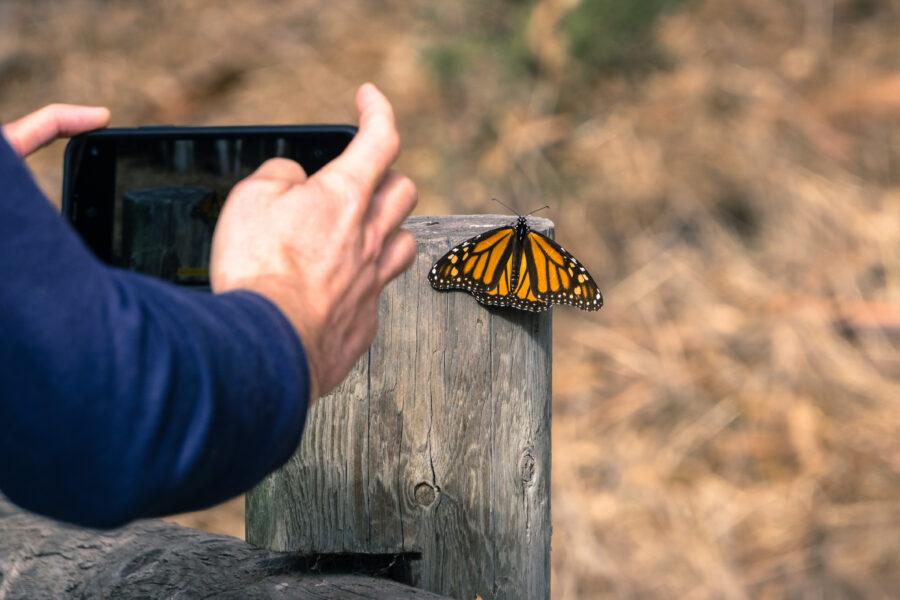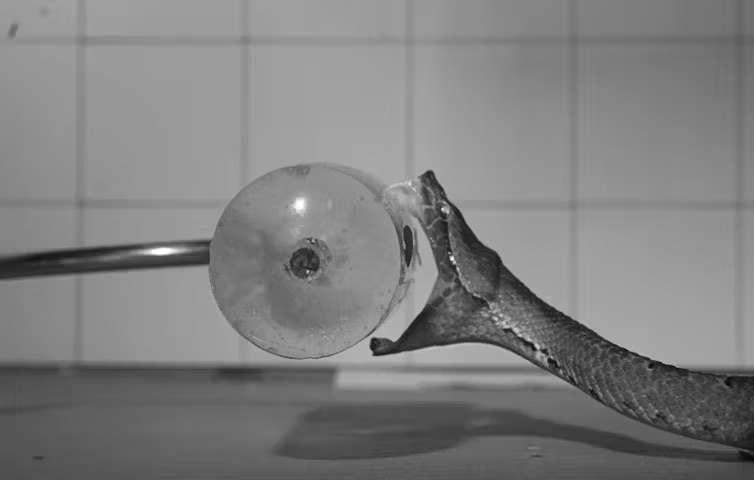Behind the scenes: Walking with Dinosaurs

MY LEGS TREMBLE AS I raise my eyes to the scaly, vicious-looking beast that towers four storeys above me. Looking like Godzilla and moving with unnerving agility is famous T. rex, in all her enormity. She cranes her veiny neck to look at me, blinks once, twice, then steps forth on her tree-trunk legs and swoops her truck-sized head, jaws gaping. An awkward sound – something like “Bwaaah!” – escapes me. Not exactly the professional demeanour I was trying to keep.
Squealing on assignment isn’t generally advisable, but in this case my outburst is taken as a compliment. I’m in a Melbourne warehouse, empty save for the fleet of inconceivably lifelike dinosaurs, and Sonny Tilders, the creative director of the animatronics team behind them.
Walking With Dinosaurs was a ground-breaking BBC TV series, first aired in 1999, that spawned an internationally acclaimed live action show. Twenty robotic dinosaurs, designed and engineered by The Creature Technology Company based in Melbourne, have toured arenas around the world since their inception in 2008.
The show’s success comes as no surprise (particularly if you’ve been face to face with one of these demonic creatures in an empty warehouse) – they look alarmingly real. In an age where billions of dollars are being pumped into an industry of 3-D films that only exist on screen, I wondered how to refer to these lifelike dinosaur robots that interact with one another before a live audience.
“This is proper 3-D,” claims Sonny, a passionate creature creator, who sees 3-D filmmaking as a bit of a rival. “As CGI gets stronger and stronger, creature shops are struggling. It’s places like ours – that have found another context for this kind of technology – that are flourishing.”
Technology brings dinosaurs to life
But in reality, he isn’t sure there are any other studios in the world like this one. All of these revolutionary robots (the first generation for the Australian and US tours, and the second generation built for Europe and Asia) were born here, in the Melbourne workshop. And this year, for the first time, the new-wave dinosaurs, with all their realistic bells and whistles, will stomp around before a home audience.
“It’s hard to compete with movies and CG,” says chief engineer Trevor Tighe, “because animated characters can walk and leap and play up to the camera.” The dream, Trevor tells me, is to enable the dinosaurs to walk on their own. He reckons it’s possible, too, given enough time and funding.
At this stage, it takes two people to operate the larger dinosaurs. A driver sits in the foundations of the creature, enclosed in a steel chassis that looks like the skeleton of an F1 race car. As the driver manoeuvres the chassis, the creature’s enormous legs follow an automated pattern that corresponds to forward or backward momentum. Personal traits, such as movement of the head, neck and tail, blinking eyes and contracting jaws, are controlled via a remote control station called a ‘voodoo rig’.
Sonny says it took the team a while to accept that they weren’t going to get the flawless appearance of on-screen productions. “With the smaller suits you can see human legs, but people forgive you for that,” he says. “We’ve embraced theatricality, and in some ways it’s more interesting because the audience is engaged in the technique. They’re marvelling at the thing walking around, but they know it’s working with hydraulics… there’s a willingness to suspend disbelief, and it’s more intellectual.”
The hydraulics system powers an immense steel framework, aided by labyrinthine wiring and scores of deep-cycle truck batteries. All this is covered with extremely life-like, synthetic skin, beneath which the creature’s muscles are simulated by bags full of polystyrene balls. These work to create a fleshy appearance, replete with authentic wrinkles and contours.
Even when the dinosaurs break, which, according to the team, has only happened a handful of times, audiences never demand their money back. “People love being fooled and they love knowing how they’re being fooled,” Sonny says. “Once, we had a big break in a torosaurus. The creature was wheeled off and he got a cheer from the crowd, like a wounded gladiator.”
Creative licence on the life of dinosaurs
Added to the suspension of disbelief is the creation of the dinosaurs’ theatrical world and their movements in it.
“A bit of artistic license is taken,” says Sonny. “An understanding of anatomy and form is part of being an artist, and everything we do has some foundation in the real world.”
The design team use modern-day animals as reference points to essentially fill in the gaps of dinosaurs’ anatomy and motion. Plastered on whiteboards around what’s known as the skin department, for example, are pictures of mighty wrinkled walruses, furry seals, reptiles and robust hippos, next to swathes of scaly fabric.
According to Sonny, the company attempts to represent a somewhat generic version of dinosaurs rather than specific species, to avoid details becoming quickly outdated. “What was important for us was to talk about the method of evolution and the mechanics behind it. If we tried to be the latest and greatest in findings, you’re out of date in three months,” he says.
David Pickering, a palaeontologist at Museum Victoria, was part of a team of advisors during the early design stages. David says there has to be an amount of creative licence used when translating fossils into moving dinosaurs, referring to the dinosaur team as “modern-day magicians” for their achievements. David says that part of the team’s decision-making process was to overlook developments in palaeontologic thinking that suggest dinosaurs were more closely aligned with birds than first thought.
“We’ll never know what colour they were; we don’t know what sounds they made,” admits David. “But one of the biggest changes in thinking about how dinosaurs looked is the amount of feathers they had. Obviously, feathers are very difficult to reproduce on a robot.”
David says there has also been a lot of dramatisation of the story. The entire production is narrated by a fictional palaeontologist, who guides the audience on a journey through the Triassic, Jurassic and Cretaceous periods, reflected by the creatures onstage.
“I know that some palaeontologists have a problem with the storyline being too speculative,” says David, “But I think that’s a case of scientists just wanting hard science. Of course, it’s entertainment.”
Passion for dinosaurs
David says the show has generally been well-received among palaeontologists, and that its helps to raise the profile of palaeontologists and their work.
“People need to have a passion for palaeontology,” David says, “and to realise it isn’t just a form of stamp collecting where we stick as many new animals in our book as we can. We want to know how animals related to one another and to the environment, because what happened in the past can tell us a lot about the present and future.”
Sonny, too, finds the evolution the most interesting aspect: “The biggest story about the dinosaurs is that they were so successful, and so broad in their development,” he says. “So they really illustrate how evolution works: how it finds niches, and exploits them.”
The production is touring arenas from April 2011, presented in proper 3-D. Squeals will be forgiven from all age groups.
VIDEO: Walking with dinosaurs show
RELATED STORIES




